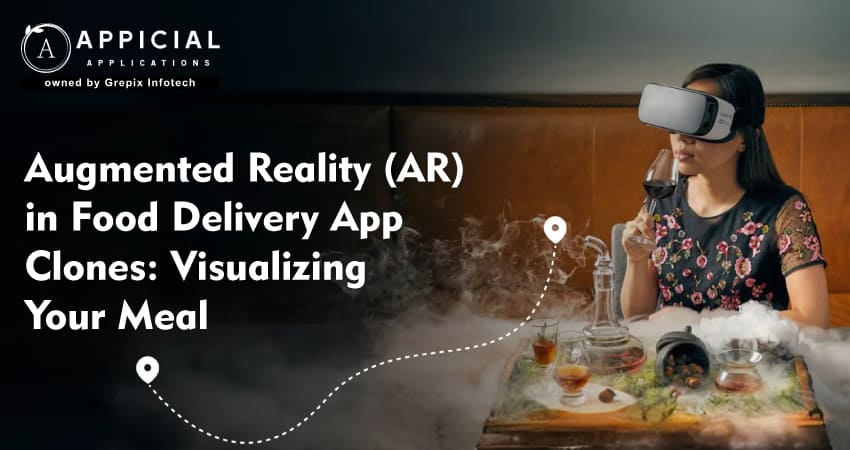
Augmented Reality (AR) in Food Delivery App Clones: Visualizing Your Meal
Ever stared at a restaurant menu and thought, “I wish I could see the food before ordering it”?
Yeah, me too.
Words can only do so much. A name like "Butter Chicken" sounds amazing, sure, but what if you could see that sizzling, creamy goodness right on your table before you placed the order? That’s where augmented reality (AR) is changing the game.
In a world of cloned food delivery apps racing to offer something new, AR is stepping up as a showstopper. Not just for fun, but for real impact, boosting customer satisfaction, reducing food returns, and making you feel like you're tasting with your eyes.
Let’s break it down. From enhancing your digital food experience to understanding how to actually build this tech into your own AR food delivery app, this blog walks you through everything.
This blog dives into how AR food delivery app features are transforming the way we order meals. From interactive augmented reality menus to immersive food app clone AR features, discover how AR enhances customer experience, learn practical implementation tips, and explore real case studies. Whether you're a business owner or developer, this piece shows how to level up your app and why Appicial Applications is the partner to make it happen.
Welcome to the Table: What Is AR in Food Delivery Apps?
AR, Augmented Reality, is basically a digital layer over the real world. Think Pokémon GO but for... dinner.
In the context of food delivery apps, it lets users point their phone at a surface and see a life-size 3D rendering of the meal they’re about to order. Imagine aiming your phone at your kitchen table and watching a steaming bowl of ramen appear, chopsticks and all.
This is what augmented reality menu systems bring to life: a preview of your order, not in abstract words, but vivid visuals. With food app clone, developers are baking this immersive tech into apps that mimic the Ubers and DoorDashes of the world, but with a mouth-watering twist.
Enhancing Customer Experience: When Seeing Is Believing
Here’s the deal: food is visual. Before you even take a bite, your brain’s already made some judgments. A good-looking dish sells itself.
So what happens when users can see the exact dish they’re ordering, in their environment, before hitting that checkout button?
They engage more. They trust more. And they’re more likely to follow through.
Let’s break down what makes AR food delivery app experiences so powerful:
1 Visual Confidence Boost
Customers often hesitate because they’re unsure of what they’re getting. An augmented reality menu clears that up instantly. You’re not reading vague descriptions; you’re looking at the plate, the garnish, even the portion size. It’s not guessing, it’s knowing.
2 Lower Cart Abandonment
Ever get to the end of your order, then bail? Happens all the time. But when users feel more confident about what they're ordering, they’re less likely to ghost your cart.
3. More Explorative Behavior
People love to play with new tech. AR isn’t just functional, it’s fun. Scrolling becomes exploring. Customers interact more with your menu. That increased screen time? Yeah, it usually turns into more orders.
4 Fewer Complaints, Fewer Returns
When people know what they’re getting, they’re less likely to be disappointed. That means fewer “this isn't what I expected” messages and more happy customers posting food pics online.
5 A Killer Brand Edge
Let’s face it. There are a ton of food apps out there. Adding AR features puts you on a different level, more premium, more tech-savvy, and honestly, just cooler.
Cooking It In: How to Implement AR in Your Food Delivery App Clone
So now you’re sold. Great. But let’s talk logistics.
Adding AR isn’t just a gimmick; it’s a strategy. You’ve got to do it right to make it worth the time and development cost. Here’s what the process typically looks like:
1 Start with 3D Models
Every dish needs to be modeled in 3D. This might sound heavy, but many restaurants already have high-res photos or CAD models for other uses. You’ll need a designer or AR specialist to translate that into interactive, scalable 3D versions.
2 Integrate AR SDKs
Apple’s ARKit and Google’s ARCore are your best friends here. These platforms let you plug AR features right into your mobile app, including surface detection, scaling, and object rendering.
3 Smart UI/UX Design
Don't just throw the AR feature in and call it a day. Think about where it makes the most sense. Let users preview before checkout. Add call-to-action buttons like “View in AR.” Keep it optional, not forced.
4 Optimize for Speed
AR can be a little heavy on load times. So compress your 3D assets, preload intelligently, and offer fallback options if the user’s device can’t handle it.
5 Beta Test the Hell Out of It
Not all devices will interpret AR perfectly. You need to test it in real-world conditions, with real lighting, on real smartphones. Bugs here can kill the experience fast.
6 Promote the Feature
You’ve built it, now shout about it. Use in-app banners, push notifications, social posts, and influencer campaigns to show off your AR-powered augmented reality menu.
Real Plates, Real Results: Case Studies of AR in Food Delivery Apps
Let’s look at a few examples where AR food delivery app features went from idea to impact.
Kabaq (Now QReal)
They were one of the early players in AR food visualization. Kabaq partnered with restaurants to build ultra-realistic 3D food models. Their AR menu allowed diners to see meals in 360 degrees, and increased conversion rates for featured dishes by over 25%.
Pizza Hut India
During a promotional campaign, Pizza Hut launched AR boxes. Scanning them with a phone launched interactive games, meal previews, and menu upsells. The result? A 30% spike in engagement and significant social buzz.
Also Read: Sustainable Practices in Food Delivery App Clones
Bareburger
This organic burger joint lets customers view their burgers in AR through Snapchat. The virtual meals appeared on your plate as if they were real. The campaign not only boosted online orders but also reinforced their brand’s tech-forward image.
These aren’t just cool tricks,they’re smart business moves. And they show how AR features can turn something as routine as ordering lunch into an experience worth remembering (and repeating).
Why AR Works So Well in Food App Clones?
Let’s be honest for a minute.
Most food delivery apps out there? They’re starting to blur together.
Same endless list of restaurants. Same menu layout. Same user ratings, filters, and cart screen.
One might be red, one might be green, but the bones are identical.
So when you’re building a food app clone, here’s the hard truth,you’re not just trying to match the big players. You’re trying to stand out from a sea of sameness. And that’s where AR doesn’t just help. It shines.
AR Isn’t a Gimmick, It’s a Game-Changer
Let’s bust a myth right off the bat: AR isn’t just “cool tech” for the sake of flashiness. When implemented with intent, it becomes a utility, a tool that improves decision-making, user satisfaction, and engagement.
Think about it from the user’s side. You're hungry. You open your app.
You scroll through endless dish names. Maybe a photo or two pops up. You’re trying to picture what it actually looks like. Will that "burrito bowl" be loaded and satisfying ,or a sad, half-empty plastic container?
Now imagine this instead: you tap on a dish, your camera opens, and boom, a life-sized 3D rendering of the exact meal appears on your desk. You can rotate it. Zoom in. See how saucy that pasta is or how tall that burger stacks.
Ordering online strips away some of that. It becomes transactional: click, pay, wait.
But AR gives you a shot at putting some of the magic back in.
It turns a lonely scroll into an interactive moment. It reconnects the customer with the meal, even before the delivery driver knocks.
And in a world that craves connection and novelty, that’s not a bonus. That’s a necessity.
That’s not just cool. That’s clarity. And clarity builds trust.
The Final Bite: Why Appicial Applications Is Your AR Partner
Look, integrating AR into a food delivery app isn’t a weekend project. You need the right tech stack, design sense, and deployment strategy.
That’s where Appicial Applications comes in.
They specialize in building smart, scalable, and stunning AR food delivery app clones. From augmented reality menu design to full-stack development and launch, they’ve got the tools and the team to bring your vision to life.
Whether you’re a startup with big dreams or an established food brand looking to innovate, Appicial helps you build not just another clone, but a next-gen platform people love using.
So what are you waiting for?
Your future users are hungry. Give them more than just food, give them a taste of what’s next.
Reach out to Appicial Applications today and start visualizing your success.
Looking out to start your own venture like Zomato? Try out our MasalaDish Zomato Clone, the easiest way to kick-start your taxi business.Author's Bio

Vinay Jain is the Founder at Grepix Infotech and brings over 12 years of entrepreneurial experience. His focus revolves around software & business development and customer satisfaction.
Back to blog list




